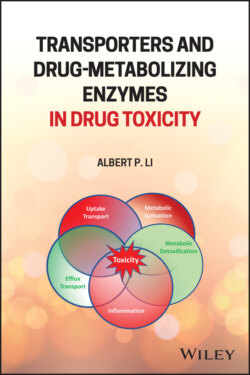Читать книгу Transporters and Drug-Metabolizing Enzymes in Drug Toxicity - Albert P. Li - Страница 21
2.1 Introduction
ОглавлениеDrug‐induced liver injury (DILI) can lead to serious clinical outcomes, including acute liver failure. Current research on DILI suggests that it is mostly idiosyncratic. It is a significant concern for drug developers and agencies, and the current testing strategies provide an unacceptably high number of false negatives [1]. In past decades over 50 approved drugs have either been withdrawn from the market or have become the focus of regulatory actions, including the addition of boxed warnings and other product labeling modifications due to DILI [2, 3]. Hepatotoxicity also is cited as one of the leading reasons for drug development failure, accounting for over 20% of failed clinical trials due to drug safety issues [4]. In 2009, the US FDA published guidance on the clinical evaluation of DILI before premarketing approval, which aimed to address the collection and evaluation of laboratory measurements that signal the potential for DILI during clinical trials [5].
The liver is the major organ for drug metabolism and receives over 80% of its blood flow from the gastrointestinal tract. It contains several enzymes with biotransformation capacity for a large variety of foreign compounds, including therapeutic medications (Figure 2.1). P450 enzymes in phase I metabolism catalyze lipophilic drug molecules into water‐soluble metabolites in order to eliminate them from the body. However, the biotransformation of these drug molecules can also form toxic reactive metabolites (RMs), which covalently bind and modify biological macromolecules such as enzymes, proteins and DNA, affecting their functions and potentially leading to toxicity. The physiological role of phase II reactions is to form conjugated products that are more water soluble than the original xenobiotic or active phase I metabolites; nevertheless, it also generates reactive conjugations that could result in toxicity.
Figure 2.1 The physiological process of drug metabolism and transport and the role of enzymes in formation of reactive metabolites and accumulation of toxic bile acids, two proven mechanisms leading to drug‐induced liver injury.
The inhibition of hepatic transporters such as the bile salt export pump (BSEP) presumably could cause toxic bile acids to accumulate in the liver and also is considered an important mechanism leading to DILI. In this chapter we will focus on drug metabolism and hepatic transporters, and their relationships to DILI. We will briefly introduce the enzymes involved in phase I and phase II hepatic metabolism and their roles in forming chemically RMs. Next, we will review the role of RMs in toxicity and how to detect and measure them using in silico and experimental approaches, as well as strategies for mitigating the risk of RMs in the drug discovery phase. We will also discuss the role of hepatic transporters and their relationship to hepatotoxicity. Finally, we will summarize the genetic variants of drug metabolism enzymes and hepatic transporters and their impact on pharmacokinetic behavior and drug safety.
